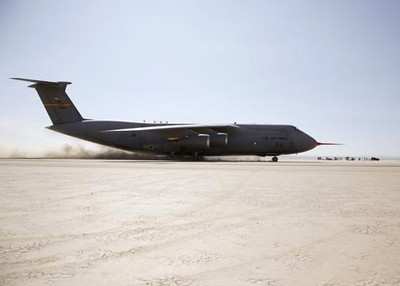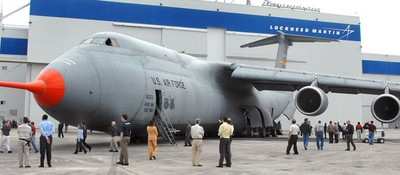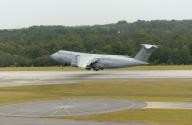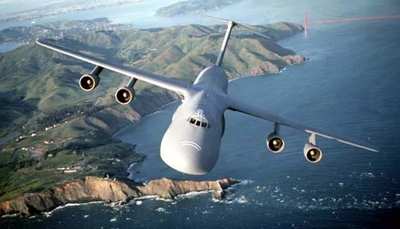That Means "Shake 'Em Until They (Almost) Break"
As part of the C-5 Galaxy's Reliability Enhancement and
Re-engining Program, the aircraft is undergoing dynamic taxi
testing to check the structural strength and flexibility of the
four-engine modification -- specifically, the C-5 structure's
movement when traveling over rougher surfaces with its new engines
and pylons.

When the C-5 was developed, it featured the first-generation,
high-bypass turbofan engine, the TF-39. The new CF6 engine is a
third-generation, high-bypass turbofan engine that produces 20
percent more thrust and consumes less fuel than the TF-39s.
Unlike the TF-39's mechanical control, the CF6 responds to
throttle commands via a digital computer. Its increased fuel
efficiency allows more cargo to be carried over a given route since
less fuel is required to make the trip.
"We are looking at the entire aircraft with these new engines,"
said Jessica Wojtanowski, a flight test engineer with the 418th
Flight Test Squadron. "We are trying to prove that the new engines
won't negatively affect the structural modes of the airplane."
The pylons and the engine are a bit heavier, so the structure's
movement has to be checked, said Mariusz Wisniewski, a 418th FLTS
Det. 4 flight test engineer.

"The dynamic testing is interesting because it involves
hard-core engineering analysis, and it allows me to operate the
airplane on the ground while controlling to very tight parameters,"
said Capt. Aaron Tucker, a 418th FLTS C-5 experimental pilot.
"It is a challenge to steer the plane within a couple of feet at
different speeds and control the ground speed within one knot," the
captain said. "It is also interesting how flight test and
structural engineers interact with each other to ensure we have a
safe test."
The 412th Test Wing Instrumentation Branch designed a ramp while
the 412th Equipment Maintenance Squadron team built four large
ramps out of plywood and metal, and installed them on Roger's Dry
Lakebed here. The ramps are designed to shake the aircraft
structure in a certain way when the C-5 rolls over it at a specific
speed. Instrumentation, such as accelerometers and strain gauges,
are installed to detect the movement of the C-5's parts.
 "We make sure the C-5
is in a tight weight band, and the instrumentation is really
precise," he said. "We designed our test so the aircraft can hit
the bumps at different speeds. We started with 30 knots and will
conclude with a 110-knot data point. We drive across the lakebed
and have to hold a precise ground speed while the aircraft has to
hit the exact center of the ramp."
"We make sure the C-5
is in a tight weight band, and the instrumentation is really
precise," he said. "We designed our test so the aircraft can hit
the bumps at different speeds. We started with 30 knots and will
conclude with a 110-knot data point. We drive across the lakebed
and have to hold a precise ground speed while the aircraft has to
hit the exact center of the ramp."
The testing will measure how well the airplane operates on an
unimproved runway in the combat area, Captain Tucker said. Runways
there tend to be bumpier sometimes due to repaired battle
damage.
"As far as the results go, the team is still working on the
numbers," he said. "As we increase the ground speed, we are getting
closer to the limit of the structure, which is what we want.
However, the test team is being more and more careful as we
proceed."
The dynamic testing is also a prerequisite of the "flutter
testing" and only a fraction of the RERP testing, Ms. Wojtanowski
said.

With flutter testing, pilots fly the C-5 at certain altitudes
and speeds out to the very limits of the aircraft envelope, she
said. The control surface will be moved rapidly, and the test team
will observe the aircraft's structural response.
"The testing on the ground helps predict the result in flight,"
Mr. Wisniewski said. "It also helps us to know if the
instrumentation works as they should in flight."
(Aero-News salutes Airman 1st Class Julius Delos Reyes, 95th
Air Base Wing Public Affairs)
 ANN's Daily Aero-Term (04.26.24): DETRESFA (Distress Phrase)
ANN's Daily Aero-Term (04.26.24): DETRESFA (Distress Phrase) ANN's Daily Aero-Linx (04.26.24)
ANN's Daily Aero-Linx (04.26.24) Airborne 04.22.24: Rotor X Worsens, Airport Fees 4 FNB?, USMC Drone Pilot
Airborne 04.22.24: Rotor X Worsens, Airport Fees 4 FNB?, USMC Drone Pilot Airborne 04.24.24: INTEGRAL E, Elixir USA, M700 RVSM
Airborne 04.24.24: INTEGRAL E, Elixir USA, M700 RVSM Airborne-NextGen 04.23.24: UAVOS UVH 170, magni650 Engine, World eVTOL Directory
Airborne-NextGen 04.23.24: UAVOS UVH 170, magni650 Engine, World eVTOL Directory






